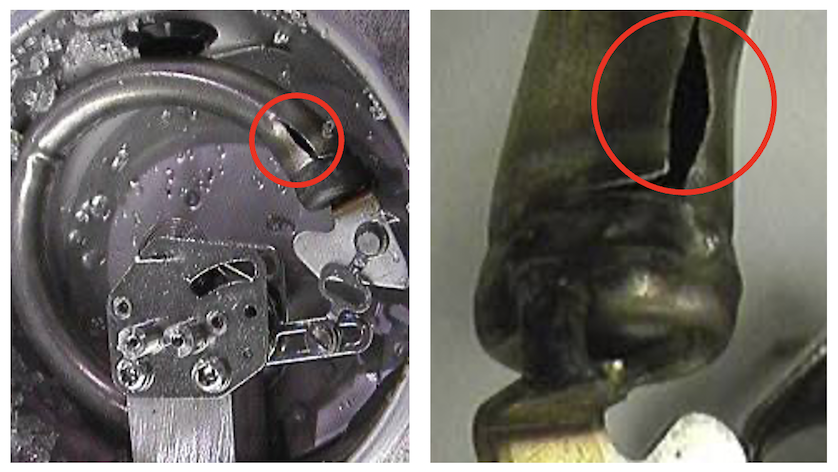
Burst pressure is a factor to consider when choosing industrial pressure gauges, but it is far from the only one or even the top criterion. Find out more about burst pressure and why WIKA USA provides this information upon request only.
When WIKA USA’s product specialists are asked to select an industrial pressure gauge for a customer’s application, we consider many factors: Will there be extreme vibration or pulsation? What are the ambient and media temperatures? Is the fluid medium corrosive or abrasive? What is the desired accuracy? We also ask about the process’s working pressures so we can recommend an industrial gauge with a high enough range to accommodate pressure fluctuations and occasional overpressure situations.
The datasheets for our approximately 120 pressure gauges include a comprehensive list of specs, from nominal sizes and detailed dimensional diagrams to accuracy classes, operating temperatures, materials, ingress protection, and much more. Yet we choose not to publish burst pressures on our website, even though some other manufacturers do and we have the data. Why is that?
Pressure Spikes, Overpressure, and Burst Pressure
In a pressure gauge, the full scale value encompasses the lowest and highest pressures that the instrument measures; this is what is shown on the dial face. Generally, if the working pressure is steady, we recommend that the top pressure be at 3/4 of the full scale value. If the pressure fluctuates, we recommend that the upper limit be at 2/3 of the full scale value. These parameters allow the Bourdon tube gauge to accommodate pressure spikes (when pressure sharply increases and then suddenly drops) and periodic overpressures (when the pressure remain near or at the maximum range).
A gauge’s burst pressure is the point at which the Bourdon tube no longer holds pressure and begins to deform and split. This is a serious issue, as a ruptured tube not only allows the process media to escape, but could also break the window and eject metal parts from the gauge internals. If the medium is caustic, a rupture event is an environmental and health hazard. In sanitary applications, such as in food/beverage and pharmaceuticals/biotechnology, a split tube leads to contamination, expensive downtime, and the need to re-sterilize the tainted process.
So, if burst pressure matters so much, why doesn’t WIKA publish it like other gauge manufacturers do? Well, we are happy to supply that information upon request. But knowing that a number can’t tell the whole story, we prefer to share our gauges’ burst pressure as part of the bigger picture.
Why WIKA Does Not Publish Burst Pressures for Gauges
Burst pressure is determined by a destructive test on a brand new gauge in a controlled laboratory setting. This theoretical value depends on the mechanical strength of the tube which, in turn, is a function of its material and dimensions (diameter and wall thickness). However, there are no industry standard tests to determine burst pressure. The burst pressure values that manufacturers publish will come from their own particular lab setups and criteria. Different testing conditions and different methods can produce different results, which makes it difficult to compare burst pressures. Also, a higher burst pressure rating does not necessarily result in a higher quality gauge. Quality is definitely not determined by the burst pressure rating.
Another critical aspect is that one cannot compare conditions in the field with conditions in a lab. The moment a gauge is put in service, it is “compromised,” as we say in the industry. The amount of pressure that a Bourdon tube can withstand in real-life situations depends on many variables, including:
- Mechanical vibration and pulsation
- Pressure spikes and overpressures
- Harsh media and corrosion
- High and low operating temperatures
- How long the gauge has been in use
Customized Pressure Gauge Advice for WIKA Customers
WIKA conducts destructive tests in a lab to determine a gauge’s burst pressure. But rather than publish each instrument’s burst pressure rating, we share that information as part of a larger conversation with customers. We want them to understand what the number means, what it doesn’t mean, and what other criteria you need to consider in order to make a well-informed product choice.
System design and safety requirements should not be based on pressure gauge burst pressures. Any time that the pressure has the potential to exceed the rated capacity of the measuring instrument, the system should be designed to eliminate such an event (see ASME B40.100 – 2013).
If overpressure (also called overload), pressure spikes, and eventually burst pressure are a concern, there are ways to accessorize the pressure gauge with protective devices, such as an overpressure protector, restrictor, snubber, or needle valve. Another solution is to select gauges that can handle overpressure and pressure spikes better than conventional gauges. These options include WIKA’s high overpressure-safe models 23X.36, 43X.36, and 43X.56.
WIKA USA wants to make sure all our customers have the industrial pressure solutions that meet their precise needs and that will provide many years of reliable service. This’s why we take the time to talk with them about all their requirements for a particular instrument – and not just the burst pressure rating. Contact us to find out more about our customer-centric approach to business.
Products mentioned in this article:
- 232.36/233.36 stainless steel Bourdon tube pressure gauge, safety version (with high overpressure safety)
- 432.56/433.56 diaphragm pressure gauges, Sealgauge® process industry series
- 432.36/433.36 diaphragm pressure gauges, safety version (high overpressure safety up to 5,800 psi/400 bar)


Super interesting and compelling counterintuitive information. Thanks for sharing!